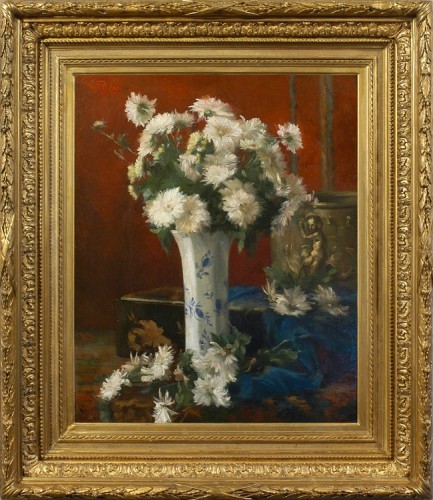An extremely stylish and pleasing composition, this dates from the final decade of Fontaine’s career. The arrangement of flowers, vase and lacquer box points to the interests of the infant and avant-garde Aesthetic movement, with its enthusiasm for japonaiserie (the box, the chrysanthemums, the blue and white china vase), and its colour harmonies. The delicate chrysanthemum petals are formed by single expert brushstrokes, the transparency of which against the red background reflects the subtle pearl shades of the foreground flowers, and offsets their pale green centres. The table-top (the guéridon) is littered with fallen flowerheads – however, this still life is not a memento mori, but a balanced and beautiful composition. The original Salon frame complements it perfectly: its rich accretion of ornament confined and undercut by the severe linear structure.
For further reading on the subject of Japonisme and Japonaiserie, please click here.
Biographical details
Victor Fontaine was born in Cuesmes, a village between Mons and le Borinage, 42 years before the young Van Gogh arrived as an evangelizing preacher to the miners of the region. Fontaine attended the Atelier Saint-Luc in Wolstraat, the Académie des Beaux-Arts de Mons, now the Ecole supérieure des Arts plastiques et visuals, and the Académie des Beaux-Arts in Brussels. In the 1860s, his style seems to have inclined to symbolism, but by the 1870s he was working in a more realist mode. He seems to have lived mainly in Brussels from the time he left the Académie, working en plein air with artists such as Félicien Rops, and – in 1875 – joining La Chrysalide, a progressive art movement which took over from the Société Libre des Beaux-Arts (Ensor first exhibited with La Chrysalide in 1881). It was formed in opposition to the official, conservative salons, and provided a means for its members to exhibit. It was replaced after its demise in the early 1880s by Les XX. Fontaine is noted particularly for all genres of arts based on the human form – portraits, figure studies, nudes and pictures of children; he also produced still life paintings. He exhibited for some years with the Cercle Artistique et Littéraire, Brussels.


